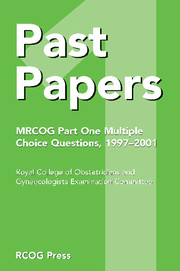Book contents
- Frontmatter
- Contents
- Introduction
- March 1997 – Paper 1
- March 1997 – Paper 2
- September 1997 – Paper 1
- September 1997 – Paper 2
- March 1998 – Paper 1
- March 1998 – Paper 2
- September 1998 – Paper 1
- September 1998 – Paper 2
- March 1999 – Paper 1
- March 1999 – Paper 2
- September 1999 – Paper 1
- September 1999 – Paper 2
- March 2000 – Paper 1
- March 2000 – Paper 2
- September 2000 – Paper 1
- September 2000 – Paper 2
- March 2001 – Paper 1
- March 2001 – Paper 2
- September 2001 – Paper 1
- September 2001 – Paper 2
- Index
September 1997 – Paper 2
Published online by Cambridge University Press: 05 July 2014
- Frontmatter
- Contents
- Introduction
- March 1997 – Paper 1
- March 1997 – Paper 2
- September 1997 – Paper 1
- September 1997 – Paper 2
- March 1998 – Paper 1
- March 1998 – Paper 2
- September 1998 – Paper 1
- September 1998 – Paper 2
- March 1999 – Paper 1
- March 1999 – Paper 2
- September 1999 – Paper 1
- September 1999 – Paper 2
- March 2000 – Paper 1
- March 2000 – Paper 2
- September 2000 – Paper 1
- September 2000 – Paper 2
- March 2001 – Paper 1
- March 2001 – Paper 2
- September 2001 – Paper 1
- September 2001 – Paper 2
- Index
Summary
1. Concerning pH:
A. In blood, pH is regulated predominantly by bicarbonate.
B. The higher the pH, the higher the hydrogen ion concentration.
C. The pH of gastric acid is 5.5.
D. The pH of urine decreases after the ingestion of ammonium chloride.
E. The pH inside cells is higher than that in plasma.
2. Concerning prostaglandins (PG):
A. Arachidonic acid is the precursor for PG biosynthesis.
B. PG synthase (cyclooxygenase) catalyses arachidonic acid conversion to PG endoperoxides.
C. Nonsteroidal anti-inflammatory drugs inhibit PG dehydrogenase.
D. Mefenamic acid is a more potent inhibitor of PG synthesis than aspirin.
E. PGF2α is excreted unchanged in urine.
3. Peripheral concentrations of catecholamines increase
A. during sleep.
B. when the nerves to the adrenal glands are stimulated.
C. when the blood sugar rises.
D. immediately following a myocardial infarction.
E. in the presence of a phaeochromocytoma.
4. The rate of transfer of a substance into a cell by passive diffusion
A. is unrelated to the concentration gradient.
B. is related to molecular size.
C. requires energy.
D. is different for stereo-isomers.
E. depends on carrier molecules in the cell wall.
5. Vitamin K
A. is synthesised by bacteria.
B. is stored in large quantities in the liver.
C. is necessary for the synthesis of factor VII.
D. is necessary for the synthesis of factor IX.
E. deficiency causes hypothrombinaemia.
6. Plasma concentrations of the following substances are typically raised in pregnancy:
A. caeruloplasmin.
B. albumin.
C. vitamin B12.
D. urea.
E. pituitary gonadotrophins.
- Type
- Chapter
- Information
- Past Papers MRCOG Part One Multiple Choice Questions1997–2001, pp. 31 - 40Publisher: Cambridge University PressPrint publication year: 2004



